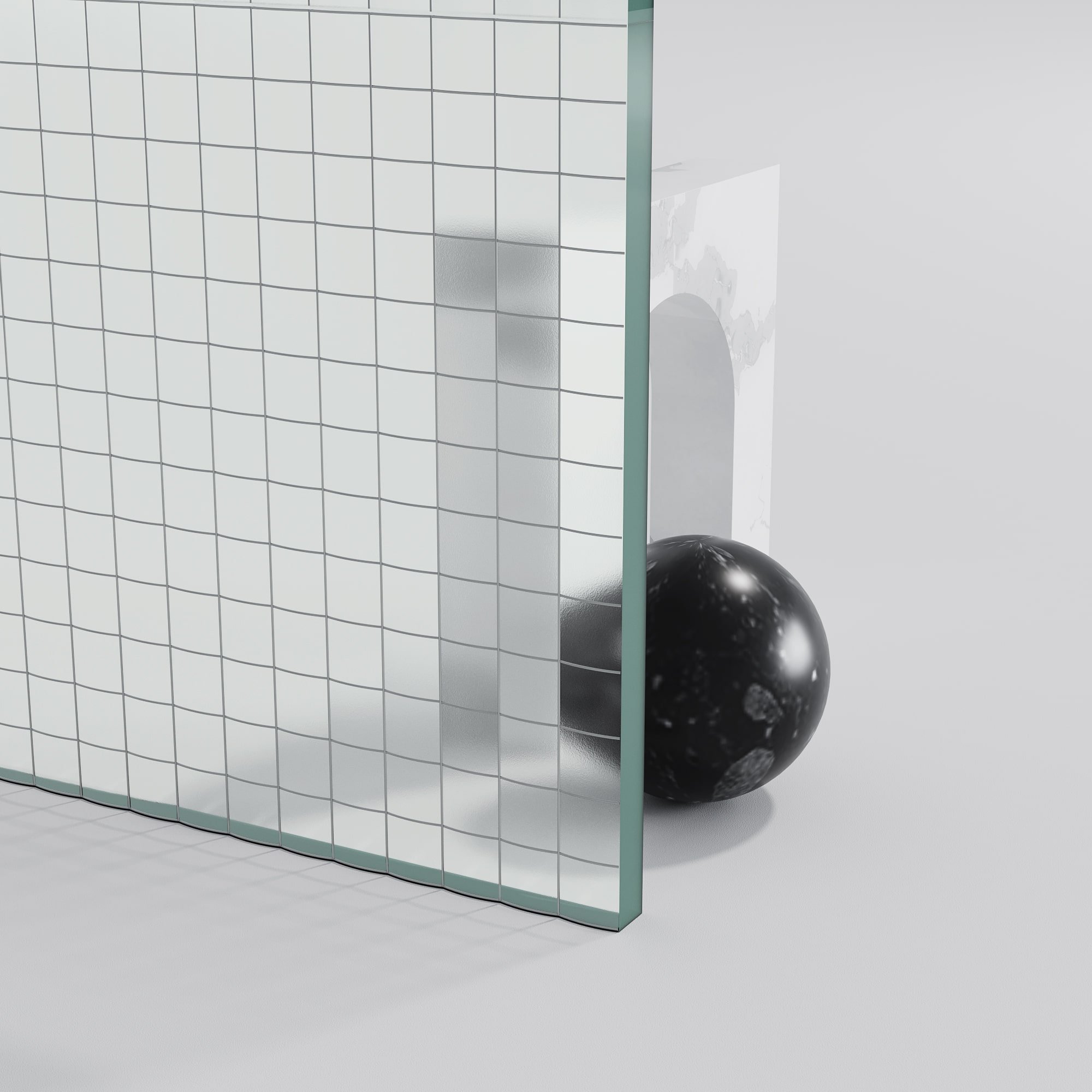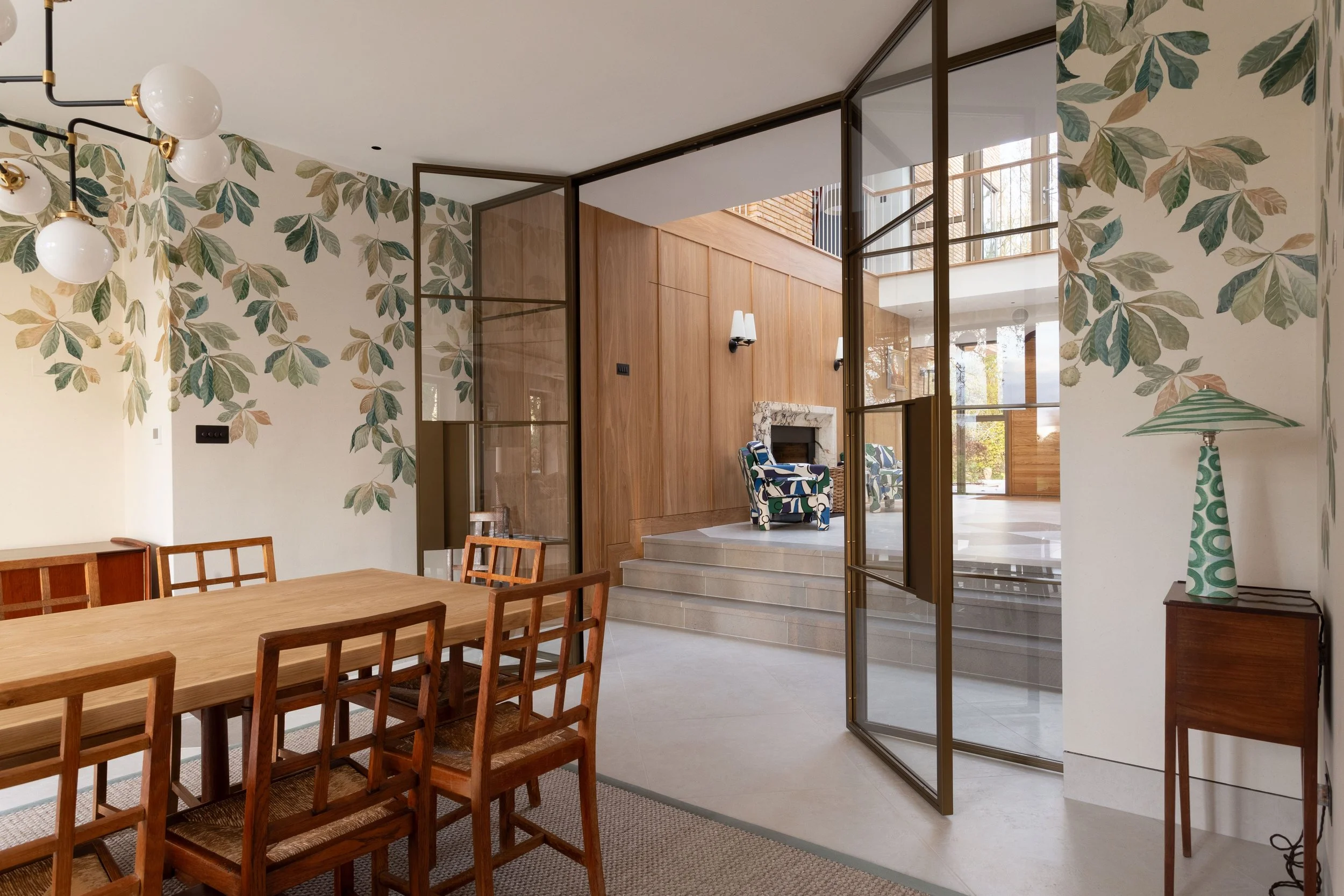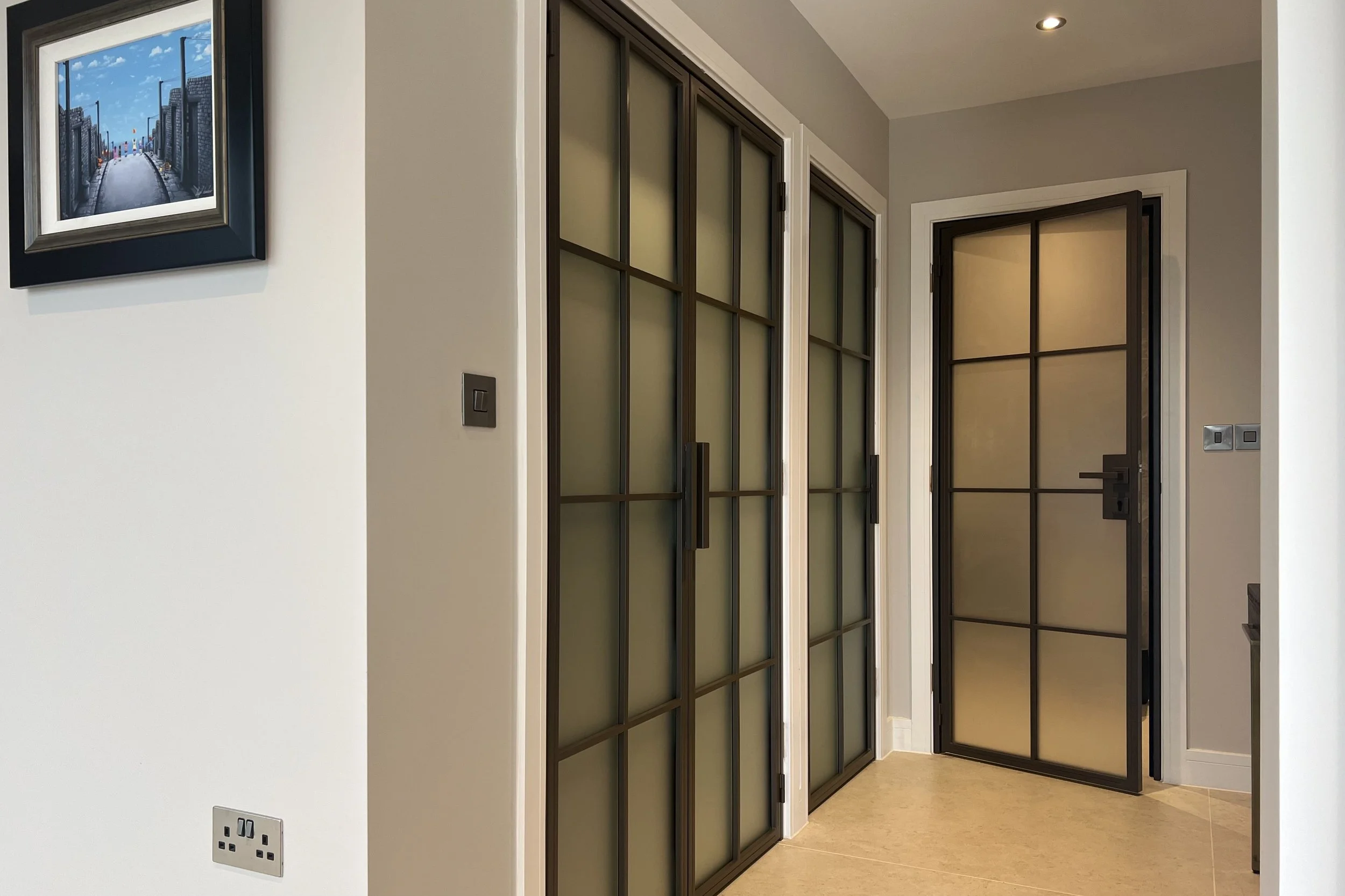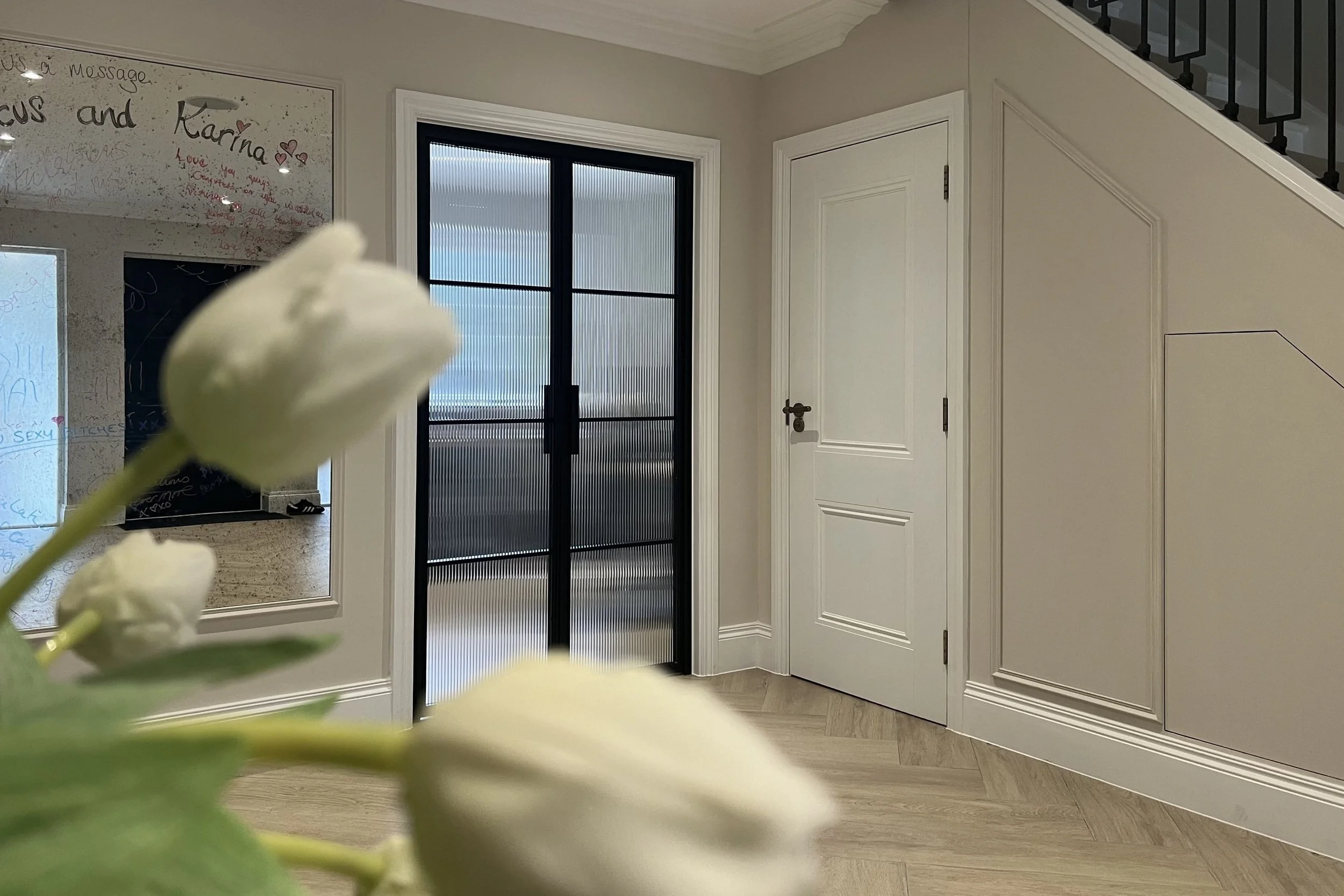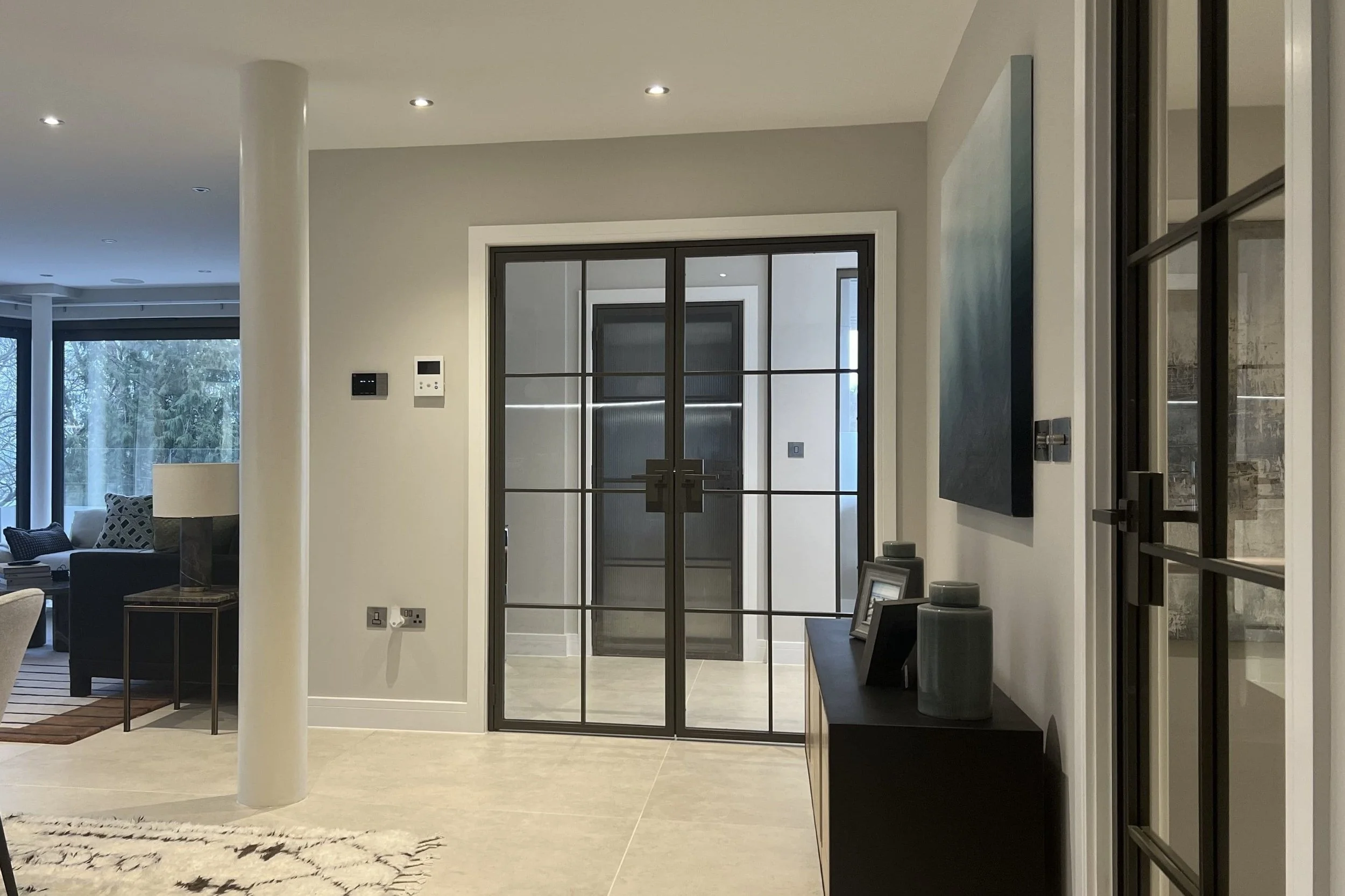Choosing the Right Glass for Your Steel Doors: Style, Privacy & Light
Introduction: Framing Light, Defining Space
Glass does more than fill a frame, it defines how a space feels, connects and glows. Within a steel-framed door, the glass is the surface that captures light, softens edges, and controls privacy.
At Joshua James, glass selection is an integral part of our bespoke process. Every pane is specified for both visual impact and functional performance. Whether your aim is open-plan flow, subtle separation or decorative definition, the glass you choose determines the mood, brightness, and intimacy of each room.
Clear Glass — Light Without Barriers
Clear glass represents openness and simplicity. It allows uninterrupted light transmission, maintaining a seamless flow between connected spaces.
Best for:
Hallways and living areas
Kitchens and dining rooms
Spaces that rely on natural light
Why clients choose it:
Clear glass keeps spaces bright and continuous, ideal for open-plan living. It ensures natural light reaches deeper parts of the home while retaining a sense of visual connection.
Design tip:
Pair with Steel Double Doors or Room Dividers to enhance sightlines and open up your interior architecture.
Opaque or Frosted Glass — Soft Light, Subtle Privacy
Frosted or opaque glass diffuses light evenly while obscuring views. It provides privacy without losing brightness — perfect for rooms that benefit from soft illumination.
Best for:
Bathrooms and dressing rooms
Home offices
Utility areas
Why clients choose it:
It brings a calm, tranquil atmosphere and a touch of softness to modern spaces. Light still passes through, but the details behind the glass fade into a gentle blur.
Design tip:
For a subtle layered look, consider frosted glass in the operable leaf and clear glass in the surrounding screen to balance visibility and privacy.
Reeded Glass — Texture, Depth, and Movement
Reeded glass introduces vertical rhythm. Its fluted surface breaks up reflections and gives interiors texture and depth while maintaining partial transparency.
Best for:
Offices and dressing rooms
Entrance areas or transitional zones
Kitchens with adjoining pantries
Why clients choose it:
It blends privacy and texture, creating visual intrigue without feeling heavy. The vertical lines elongate walls and doors, adding architectural detail even in minimalist settings.
Design tip:
Reeded glass pairs beautifully with black or bronze frames. For additional refinement, combine it with brass hardware from our Premium Handle Collection.
Grey Tinted Glass — Calm, Balanced, Architectural
Grey tinted glass offers a cool, neutral tone that softens glare and adds subtle contrast. It complements both industrial and minimal design schemes.
Best for:
South-facing rooms
Apartments and contemporary homes
Monochrome or neutral interiors
Why clients choose it:
It filters light to create calm, balanced spaces while maintaining visibility. The soft grey tone works particularly well with stainless steel, brushed brass, and anthracite frames.
Design tip:
Use in Sliding Doors to maintain openness while controlling brightness.
Bronze Tinted Glass — Warmth and Subtle Luxury
Bronze tinted glass brings warmth and richness to interiors. It filters light with a gentle amber tone that feels inviting and sophisticated.
Best for:
Bedrooms and dining areas
Kitchens with timber or stone finishes
Homes with warmer colour palettes
Why clients choose it:
The bronze tint reduces harsh light and adds depth to the view beyond. It’s particularly effective in settings with layered lighting or golden accents.
Design tip:
For a cohesive statement, pair bronze glass with matching bronze powder-coated frames or antique brass handles.
Mirror Glass — Reflection and Light Play
Mirror glass introduces reflection as an active design element. It expands smaller rooms, enhances brightness and conceals what lies beyond.
Best for:
Dressing rooms
Hallways or compact spaces
Utility rooms or pantries
Why clients choose it:
It creates an elegant illusion of space and works as both feature and function. When used within fixed panels, it reflects light to the darker side of the room.
Design tip:
Pair mirrored screens with steel-framed pivot or sliding doors for a refined architectural look.
Antique Mirror — Texture, Heritage, and Depth
Antique mirror glass introduces a handcrafted patina with delicate mottling. It’s characterful and slightly reflective, offering a softer alternative to full mirror glass.
Best for:
Feature partitions
Boutique-style spaces
Dressing rooms
Why clients choose it:
It balances reflection with warmth, making interiors feel layered and lived-in. It adds artistry to modern homes and authenticity to heritage properties.
Design tip:
Antique mirror works particularly well with aged brass or bronze finishes and dark neutral frames.
Georgian Wired Glass — Strength and Style
Recognised by its square wire mesh pattern, Georgian wired glass is both durable and decorative. It embodies industrial heritage while meeting modern safety standards.
Best for:
Period properties
Kitchens and utility rooms
Industrial or heritage interiors
Why clients choose it:
It carries timeless appeal and practical strength. The embedded wire grid provides both reinforcement and aesthetic character.
Design tip:
Pair Georgian wired glass with a traditional bar design for a standout result.
Combining Multiple Glass Types — Contrast, Privacy & Design Harmony
Using more than one glass type within a single steel door can create a striking visual contrast while offering a practical balance between light and privacy. This approach allows designers to fine-tune the function and feel of each opening — ideal for spaces that bridge different uses or moods.
Best for:
Kitchens adjoining utility rooms
Bathrooms or dressing rooms connected to bedrooms
Open-plan spaces where some privacy is still required
Why clients choose it:
A mix of glass types, such as clear and opaque or reeded and tinted, allows for creative zoning. For example, a door might feature clear glass in its upper sections to let in daylight and frosted glass below to conceal furniture or personal items. This layered approach keeps spaces bright yet intimate. Another option would be to use different glass types in the door and screens to create a clear difference.
Another effective approach is to use different glass types between the door and surrounding screens. This creates a clear visual distinction while maintaining a cohesive overall design.
For instance, pairing clear glass in the door with frosted or reeded glass in the fixed screens allows for privacy at the edges while keeping the central view open and light. Conversely, opaque glass in the door with clear side screens can subtly highlight the doorway as a feature.
This contrast not only enhances functionality but also adds architectural rhythm — a way to define zones, guide light, and introduce variation without changing the frame design.
It’s also an elegant way to visually link adjoining rooms with different functions, maintaining cohesion while subtly adjusting transparency.
Design tip:
For refined visual balance, ensure the transition between glass types aligns with one of the horizontal bars of the steel framework. The result feels intentional and architectural, rather than decorative.
Coordinating Glass Across a Home
In multi-room projects, different glass types can serve distinct purposes while maintaining a unified visual rhythm.
For example:
Clear glass for living spaces
Reeded glass for offices or dressing rooms
Diffused glass for bathrooms
Bronze or grey tint for tonal balance
This strategic approach maintains privacy where required while preserving architectural harmony throughout.
Conclusion: Defining Spaces Through Light
Every glass type carries its own language of light. From clear openness to textured privacy, each choice alters how a room feels and connects.
At Joshua James, we guide clients through each option to ensure both the aesthetic and function align perfectly with the home. Whether your project calls for clarity, opacity, reflection or tone, we’ll help you find the perfect match.
Enquire Today to discuss your project or request glass samples.
Let’s Talk
Whether you're renovating a home, specifying for a new build, or delivering a luxury interior for a client — we’re here to help.
At Joshua James, we work with architects, interior designers, homeowners and contractors across the UK to design and supply bespoke steel internal doors. Every door is crafted to exacting standards, tailored to suit each project’s vision, and built to stand the test of time.
If you're ready to elevate your next project with precision-made steel framed doors, let’s talk.







